Construction began in 1805
Please note that this text is an extract from a reference work written in 1990. As a result, some of the content may not reflect recent research, changes and events.
In August 1803 the town commissioners allowed the Prince of Wales to close off that part of Great East Street that ran past his Marine Pavilion, provided that a parallel road was constructed as a replacement. The New Road was subsequently laid out in 1805, by soldiers under the supervision of William Porden, along Furner’s Garden which the Prince had acquired the previous year. The new thoroughfare was developed with buildings over the next fifteen years or so, and by 1818 fifteen houses were occupied. The trees were planted in 1812. {112,194}
There are a number of interesting buildings in the road. The attractive nos.3-8 are listed houses faced in yellow brick, jointed with giant pilasters and embellished with wide bow windows. No.10, the Colonnade public house , stands within the frontage of the Theatre Royal and opened as a hotel in the early 1850s. In 1923 it was purchased by the theatre, resold in 1935, and purchased again by the theatre in 1953 for £5,900.
The colonnade itself, once known as the Royal Colonnade, is a listed structure and was originally built in 1806-7 on Doric columns in front of the Theatre Royal only. In 1823 it was extended on Ionic columns by Cooper and Lynn around the corner to 157 North Street, now part of the National Westminster Bank. The section outside the theatre from no.9 to no.12 was replaced in 1894 when the theatre was reconstructed, and now has terracotta columns with Corinthian capitals; the height was also increased by two feet and it does not therefore match the adjacent section. Portions of the colonnade were removed in 1912, 1922, and finally in June 1929 as part of the North Street widening scheme such that now only that section at nos.6-12 New Road remains. In the nineteenth century the colonnade was notorious as the haunt of prostitutes at theatre and music hall closing times.
The Family Assurance offices at 16-17 New Road stands on the site of a second theatre. Erected on the site of the New Oxford Music Hall which was destroyed by fire in 1892, it was a four-storey, Louis XVI-style building with a decorated facade and an elaborate plaster-work interior. Opening as the Empire Theatre, its name was changed in 1905 to the Coliseum Theatre of Varieties, and again in 1907 to the Court Theatre. In 1909 the building was converted to a cinema, sound equipment being installed in 1929. Following the war the Court was taken over by J.Baxter Somerville, manager of the nearby Theatre Royal , and it reopened on 24 May 1947 as the Dolphin Theatre, presenting fortnightly repertory productions. In 1952 it was renamed Her Majesty’s Theatre, and changed its name for the last time in April 1955 when it was converted into the Paris Continental Cinema, specialising in foreign films. After reverting to repertory in 1957, the Paris Theatre closed in March 1963 and was demolished in 1967. {68,68a,123} The offices at no.20, designed by Miller Bourne, won a 1989 council planning award. {123}
Three more listed buildings stand at the northern end of the road. The Unitarian Church, more properly known as Christ Church, was built in 1820 by A.H.Wilds. With its portico and giant fluted Doric columns, the building was modelled on the Temple of Theseus at Athens; internal alterations were made in 1938 and 1966. No.23 New Road is an elegant red-brick building, probably by Amon Wilds, and is adorned with a bow, iron balcony, and Ionic open-work pilasters. No.24, an attractive bow-fronted building in flint cobbles, opened as the Regent Hotel but was used by Crabb’s Wine Merchants from 1808 until the 1980s.
Some early 19th century buildings also stand on the eastern side of New Road, but the Pavilion Theatre was added in 1934 and is dealt with under ” Dome and Corn Exchange “. The two K6-style telephone boxes are listed as being of special architectural interest as British Telecom replaces this type of kiosk. {44,64a,235}
Any numerical cross-references in the text above refer to resources in the Sources and Bibliography section of the Encyclopaedia of Brighton by Tim Carder.

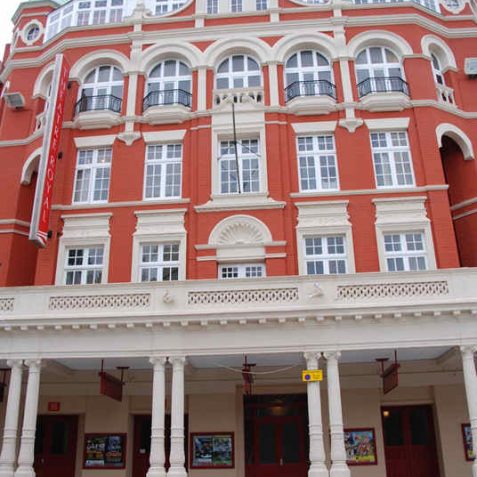


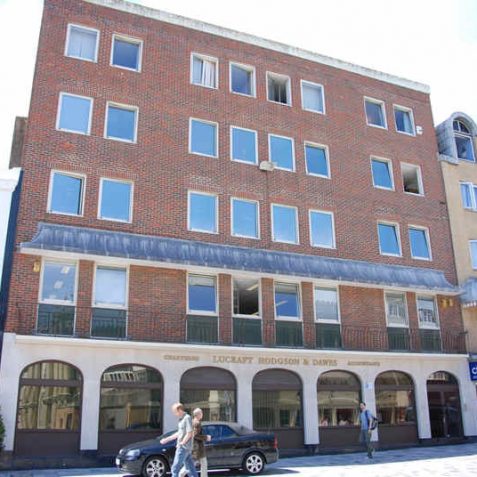
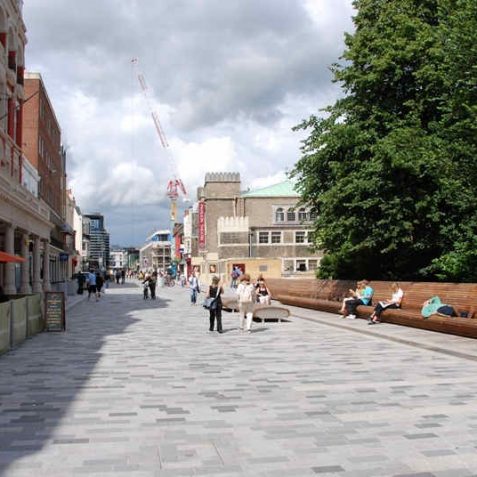
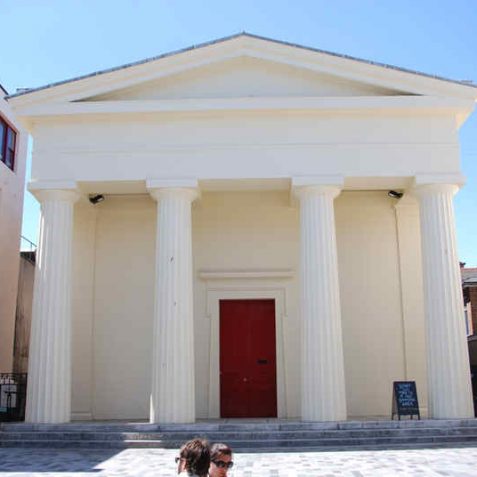
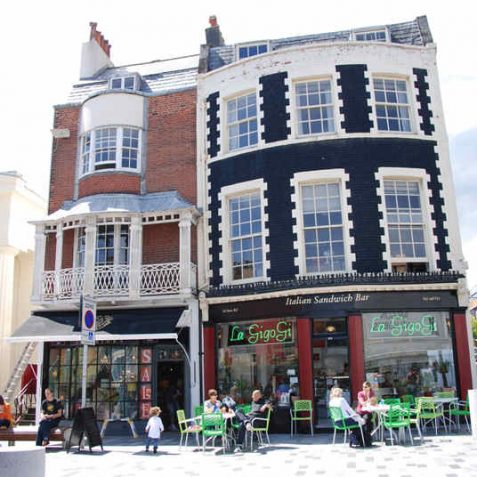

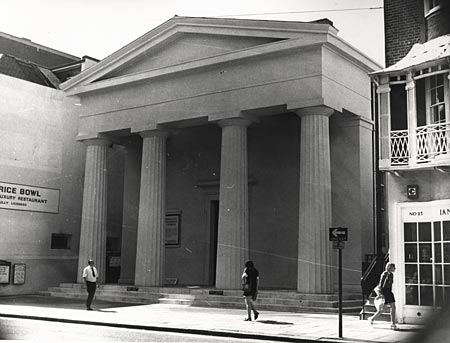
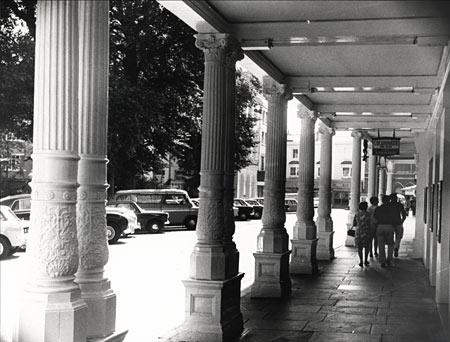
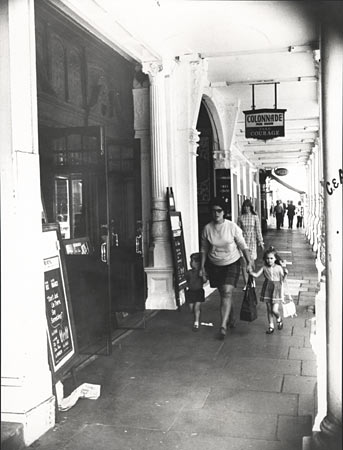




Comments about this page
That corner building during the ’50s was Crabbes, wine, beer and spirits merchant. As a spotty faced youth from the Brighton Herald (Pavilion Buildings) one of my jobs on Friday evening, as the paper was going to press, was to go get a bottle of Merrydown cider for Charles Tester, the works manager. Also had to find at least 20 Players or Capstan Full Strength cigarettes (there was a shortage for some reason) from somewhere. Wouldn’t be allowed now of course, as I was only 15, and C. H. Tester was a magistrate to boot!
I can remember when this was the Dolphin Theatre, which must have been early 1950s, when I was an office boy for the Brighton Herald. Always thought how strange it was to have two theatres virtually next door to each other. Where the people are, just further on was a lovely little “Tob ‘n Con” where I would shop for the works employees. In the 1990s, I used a DIY shop in Portland Road, Hove run by a gent named Harvey. He told me he once owned that same shop! Must have been a gold mine!
After the war we moved into the Fitzherbert building next to the pub and operated an antique shop. It was very tight with small rooms and narrow stairs. We shared an alley with the pub and Mum kept her bike in the backyard. My brother and I shared an attic room with a window, from where we could see the marvellous Dome. Of course I played in the pavilion and we enjoyed giving Sam the keeper a hard time chasing us. One day there was an army ceremony on Church St which fascinated me, and have often wondered what it was about. There was also a trade show in the Dome introducing the new Jaguar with the slogan ‘Grace, Space and Pace,’ and I remember the excitement when Winston Churchill came to the Dome for the 1948 Conservative convention.
Hi Richard, I think I have some photos of Winston Churchill at the Dome and Pavilion in 1948; I will post soon!
Add a comment about this page